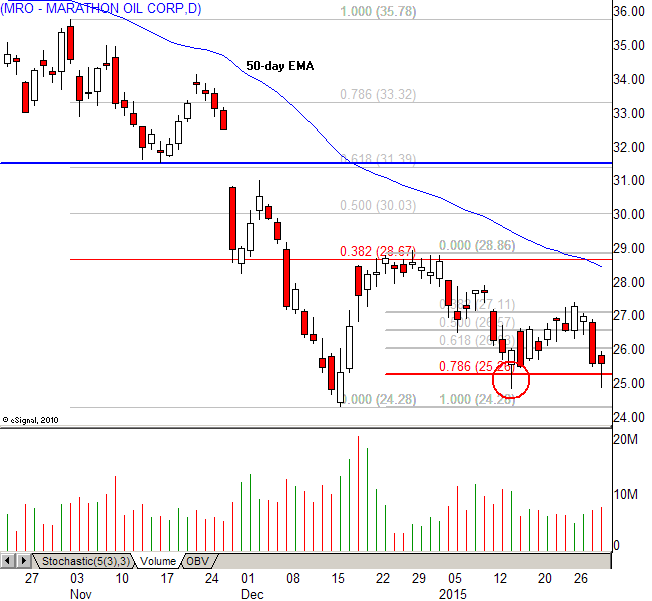Top Strategies For Mastering Pullback Trading (MSFT JNS JCP MRO)
Post on: 18 Апрель, 2015 No Comment

Pullbacks generate all sorts of trading opportunities after an active trend thrusts higher or lower but profiting with this classic strategy is harder than it looks. For starters, the security you just bought on the dips or sold short into resistance can keep on going, forcing your position into a sizable loss, or it can just sit there gathering dust while you miss out on a dozen other trades. So what skills are needed to book reliable profits with pullback strategies, how aggressively should those profits be taken and how do you admit you are wrong without breaking the bank? (for related reading, refer to Trading Opportunities on Short-Term Pullbacks )
Let’s outline the most favorable technical conditions for a pullback to turn on a dime as soon as you take risk in the opposite direction. First, you need a strong trend so that other pullback players will be lined up right behind you, ready to jump in and turn your idea into a reliable profit. Securities lifting to new highs or dumping to new lows fulfill this requirement after they push well beyond a notable breakout or breakdown level. Vertical action into a peak or trough is also needed for consistent profits, especially on higher-than-normal volume, because it encourages rapid price movement after you get positioned. It is also best when the trending security turns quickly after topping or bottoming out, without building a sizable consolidation or trading range. This is needed because the intervening range will undermine the profit potential during the subsequent bounce or rollover (for related reading, refer to The Anatomy Of Trading Breakouts ).
Microsoft (MSFT ) builds a three-month trading range below 42 and breaks out on above average volume in July, rising vertically to 45.73. It pauses for a week and sells off, giving up nearly 50% of the prior uptrend. and comes into strong support at the breakout level and 50-day EMA. A midday turnaround prints a small doji candlestick (red circle), signaling a reversal. which gathers momentum a few days later, lifting more than 2 points into a test of the prior high. The stock then resumes its strong uptrend, printing a series of multi-year highs. (for additional reading, refer to Candlesticks Light The Way To Logical Trading )
Finding The Perfect Entry Price
Look for cross-verification once the pullback is in motion. This term denotes narrow price zones where several types of support or resistance line up, favoring a rapid reversal and a strong thrust in the direction of the primary trend. The odds for a bounce or rollover increase when this zone is tightly compressed and diverse kinds of support or resistance line up perfectly. For example, a selloff to a breakout through horizontal highs that also aligns with a key Fibonacci retracement and an intermediate moving average. such as the 50-day EMA, raises the odds significantly for a successful pullback trade. Even so, you can enter pullbacks in less advantageous circumstances by scaling into conflicting price levels, treating support and resistance as bands of price activity rather than thin lines.(for related reading, refer to Strategies For Trading Fibonacci Retracements )
Janus Capital Group (JNS ) carves out a 9-month trading range with resistance at 13 and goes vertical in a heavy volume breakout after a well-known hedge fund manager joins the company. The news posts a huge one-day gain, giving way to an immediate pullback that lands on new support at the top of the range, now perfectly aligned with the 62% Fibonacci retracement and 50-day EMA. The stock turns on a dime, jumping back above 15 and resuming the uptrend at a slower pace. It prints a six-year high two months later.
Taking Opportunistic Profits
Take profits aggressively after trade entry or scale out. pocketing cash as the security recovers lost ground. Customize risk management to the specifics of that retracement pattern by placing Fibonacci grids over a) the last wave of the primary trend and b) the entire pullback wave. This combination can reveal harmonic price levels where the two grids line up, pointing to hidden barriers. Gaps and small trading ranges also need to be watched for counterswings because pullback plays always carry the risk of printing lower highs in uptrends and higher lows in downtrend. In most cases, the best exits will occur when price moves rapidly in your direction into an obvious barrier, including the last major swing high in an uptrend or swing low in a downtrend (for related reading, refer to Introduction To Swing Charting ).
Marathon Oil (MRO ) breaks 19-month support at 31 in November, in sympathy with declining crude oil prices. The high volume decline bottoms at 24.28 a few weeks later, giving way to a pullback that stalls at the 38% Fibonacci selloff retracement and setting up a low risk short sale pullback entry. A second retracement grid placed over the pullback wave assists trade management, picking out natural zones where the downtrend might stall or reverse. The bull hammer reversal at the 78.6% retracement in January (red circle) warned that short sellers could be targeted, favoring a rapid exit to protect profits.

Effective Stop Loss Strategies
Losing trades with pullback plays tend to occur for one of three reasons. First, you miscalculate the extent of the countertrend wave and enter too early. Second, you enter at the perfect price but the countertrend keeps on going, breaking the logical mathematics that set off your entry signals. Third, the bounce or rollover gets underway but then aborts, crossing through the entry price because your risk management strategy failed. The final case is the easiest to manage. Place a trailing stop behind your position as soon as it moves in your favor and adjust it as the profit increases.
The stop needed when you first enter the position is directly related to the price chosen for entry. As you gain experience, you will notice that many pullbacks show logical entries at several levels. The longer you wait and the deeper it goes without breaking the technicals, the easier it is to place a stop just a few ticks or cents behind a significant cross-verification level. You will miss perfect reversals at intermediate levels with a deep entry strategy but it will also produce the largest profits and smallest losses. If you choose to take many shots at intermediate levels, the position size needs to be reduced and stops placed at arbitrary loss levels such as 25- to 50-cent exposure on a blue chip and one- to two-dollar exposure on a high beta stock such as a junior biotech or China play.
JC Penney (JCP ) breaks out above a 9-month trendline and rallies to a 52-week high at 11.31. It turns lower in mid-September after carving a three-week trading range and lands on triple support at the trendline, 50- and 200-day EMAs. The stock bounces just under support, drawing in dip buyers but the recovery wave stalls, triggering a failed breakout. A pullback play taken on the bounce requires a stop loss below that session’s low (red line) because price action into that level will flash all sorts of sell signals.
The Bottom Line
Breakouts and breakdowns often return to contested levels, testing new support or resistance after the initial trend wave runs out of steam. Pullback positions taken close to these price levels show excellent reward to risk profiles that support a wide variety of swing trading strategies (for additional reading, refer to Introduction To Swing Trading ).














